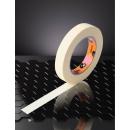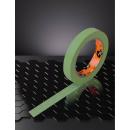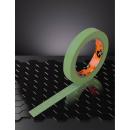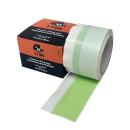Bodywork Masking tape

Masking tape for car bodywork
-
 1126.1850Premium 80° Masking tape18mm x 50m white - 1 box
1126.1850Premium 80° Masking tape18mm x 50m white - 1 box -
 1126.3650Premium 80° Masking tape38mm x 50m white - 1 box
1126.3650Premium 80° Masking tape38mm x 50m white - 1 box -
 1126.4850Premium 80° Masking tape50mm x 50m white - 1 box
1126.4850Premium 80° Masking tape50mm x 50m white - 1 box -
 1131.1850Masking tape 90°C18mm x 50m - HYDRO special
1131.1850Masking tape 90°C18mm x 50m - HYDRO special -
 1131.245090° Masking tapegreen 24 x 50m - HYDRO special
1131.245090° Masking tapegreen 24 x 50m - HYDRO special -
 1131.365090° Masking tape36mm x 50m - special HYDRO
1131.365090° Masking tape36mm x 50m - special HYDRO -
 1131.4850Masking tape 90°C50mm x 50m - special HYDRO
1131.4850Masking tape 90°C50mm x 50m - special HYDRO -
 1196.2075Protective tapepremium gasket - 75mm x 20m
1196.2075Protective tapepremium gasket - 75mm x 20m
︾
Presentation of the bodywork Masking tapes available on Carross :
Bodywork masking tape is an essential tool used in car repairs for a number of reasons. Here are its main uses:
Protecting areas that should not be painted:
Masking tape is used to protect areas of the bodywork that should not be painted. It allows you to precisely delineate areas to be painted and those to be left unpainted, such as windows, headlights, bumpers and other specific elements.
Precision when painting :
By clearly delimiting the areas to be painted, Masking tape ensures a precise, professional finish. It helps to avoid unwanted paint spillage and to achieve clean, defined lines.
Protection from splashes and mists:
When painting, especially when spraying, Masking tape protects areas not intended to receive paint from paint splashes and mists.
Facilitating the masking process:
Masking tape is designed to be easily applied and removed. This simplifies the masking process, saving time and effort during bodywork preparation prior to painting.
Use for touch-up work:
When touching up paint on small areas, Masking tape is particularly useful for precisely delineating the area to be painted, allowing targeted paint application.
Protecting joints and crevices:
Masking tape is often used to protect joints, crevices and other hard-to-reach areas where paint could seep through and create problems.
Use with other protective products:
Masking tape is often combined with other protective products such as masking sheets, plastic bags, or protective films to create an effective barrier against paint.
Different types of tape for different uses:
There are different types of Masking tape adapted to specific needs, such as precision Masking tapes, heat-resistant tapes, and tapes adapted to different surfaces (plastic, metal, etc.).
In short, bodywork Masking tape is a key accessory that helps ensure a precise, clean and professional paint application. Its use is essential to protect areas that are not intended to be painted and to ensure quality workmanship during car repairs and paintwork.
Our range of car body masking tapes:
The different types of tape used in bodywork serve specific purposes depending on the needs of the work to be carried out. Here are some explanations of the differences between standard Masking tape, windscreen sealing Masking tape, reinforced Masking tape and joint protection tape:
Standard Masking tape :
Function : Standard Masking tape is used to delineate areas of the bodywork that are not to be painted. It provides a temporary barrier and prevents paint from spreading to unwanted areas.
Characteristics : This type of tape is generally made of crepe paper or plastic. It is designed to be easy to tear and apply.
Masking tape for windscreens:
Function : Unlike standard masking tape, windscreen sealing masking tape is specially designed to provide a seal when reinstalling or repairing a windscreen.
Features : It is often made from weather-resistant and waterproof materials. It also provides extra grip to hold the windscreen in place.
Reinforced Masking tape :
Function : Reinforced Masking tape is designed to offer extra strength. It is used in situations where greater holding power is required, for example to hold plastic protectors in place during painting.
Features : It can be reinforced with fibres or filaments to make it stronger. This allows the tape to withstand mechanical loads without tearing.
Joint protection tape :
Function : Joint protection tape is used to protect joints and crevices against the ingress of paint or other products. It creates an effective barrier to prevent unwanted spills.
Characteristics : It is often thinner and more flexible, allowing it to adapt to the contours and shapes of bodywork joints.
It's important to choose the right type of tape to suit the specific needs of each bodywork job. Using the right Masking tape ensures accurate paint application, protection of the necessary areas and professional quality results. In addition, following the manufacturer's instructions on how long to leave it in place and the application process is crucial to ensuring effective use.
Bodywork Masking Tape FAQs:
Using bodywork Masking tapes is a crucial step in the car repair and paint process. Here are answers to the most common questions asked by users about the use of these specific tapes:
1. Why should I use bodywork Masking tape?
Masking tape is essential for demarcating areas to be painted, protecting unwanted surfaces and ensuring accurate paint application without unwanted overspray.
2. What's the difference between standard masking tape and reinforced masking tape?
Reinforced masking tape is reinforced with fibres or filaments, providing extra strength. It is ideal for situations requiring greater holding power, such as holding protections in place during painting.
3. Can Masking tape be used on all bodywork surfaces?
Yes, Masking tape is generally designed to be used on a variety of surfaces, including paint, glass, plastic and metal. However, it is advisable to check the tape's compatibility with the specific material.
4. How can I prevent paint from seeping under Masking tape?
Make sure the surface is clean and dry before applying the tape. Press the tape firmly to create a watertight barrier. For extra protection, some users apply a thin layer of Clearcoat or sealer along the edge of the tape.
5. Can I reuse Masking tape that has already been used?
Reusing Masking tape is generally not recommended, as it may have lost its original adhesion and may not provide sufficient protection when reapplied.
6. How can I prevent the tape from pulling off the existing paint?
Remove the tape carefully and at a low angle to the surface. It is also advisable to remove the tape shortly after painting, when the paint is still supple.
7. Are there specific tapes for Masking around windows or joints?
Yes, there are masking tapes specially designed for joints and contours. These tapes are often thinner and more flexible, allowing them to be adapted to the shape and contours of surfaces.
8. Can I paint directly on Masking tape?
It is generally not advisable to paint directly on Masking tape, as this can compromise its adhesion and lead to overspray. Remove the tape after applying the paint for best results.
9. How do I choose the width of Masking tape?
The width of the tape depends on the area you want to mask. For precise lines, use a thinner tape, while for wider protection, opt for a wider tape.
10. Are there specific Masking tapes for water-based or solvent-based paints?
Yes, some Masking tapes are formulated to be compatible with water-based or solvent-based paints. Check the manufacturer's specifications to make sure you're using the right type of tape.
By understanding these answers to frequently asked questions, users can maximise the effectiveness of bodywork Masking tapes, contributing to accurate and professional paint jobs. It's essential to choose the right tape for the specific needs of each project.